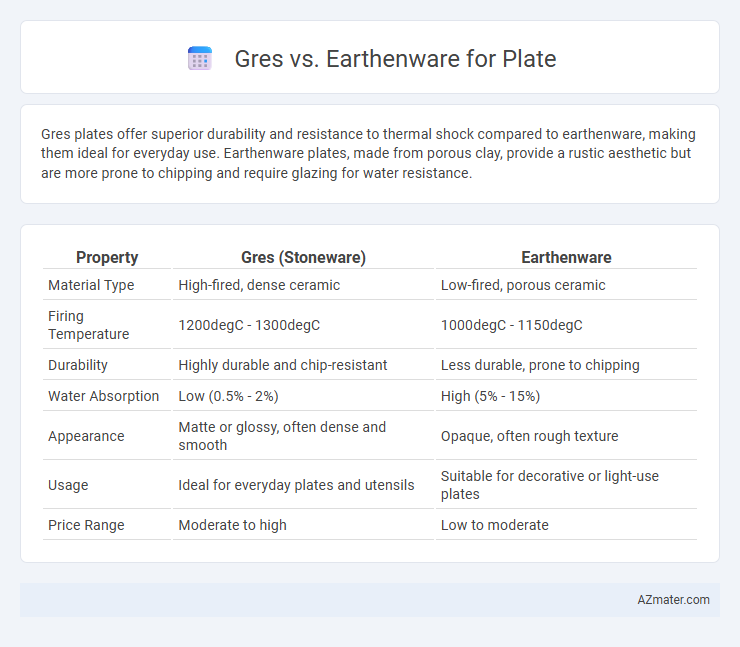Gres plates offer superior durability and resistance to thermal shock compared to earthenware, making them ideal for everyday use. Earthenware plates, made from porous clay, provide a rustic aesthetic but are more prone to chipping and require glazing for water resistance.
Table of Comparison
| Property | Gres (Stoneware) | Earthenware |
|---|---|---|
| Material Type | High-fired, dense ceramic | Low-fired, porous ceramic |
| Firing Temperature | 1200degC - 1300degC | 1000degC - 1150degC |
| Durability | Highly durable and chip-resistant | Less durable, prone to chipping |
| Water Absorption | Low (0.5% - 2%) | High (5% - 15%) |
| Appearance | Matte or glossy, often dense and smooth | Opaque, often rough texture |
| Usage | Ideal for everyday plates and utensils | Suitable for decorative or light-use plates |
| Price Range | Moderate to high | Low to moderate |
Introduction to Gres and Earthenware Plates
Gres plates, also known as stoneware, are made from dense, non-porous clay fired at high temperatures around 1200-1300degC, resulting in durable and chip-resistant dishware ideal for everyday use. Earthenware plates, crafted from porous clay fired at lower temperatures between 1000-1150degC, feature a more rustic, absorbent surface requiring glazing to prevent moisture absorption and enhance durability. The difference in firing temperature and clay composition gives gres plates superior strength and stain resistance compared to the more fragile and porous earthenware counterparts.
Material Composition: Gres vs Earthenware
Gres plates are made from high-fired stoneware clay, resulting in a dense, non-porous material that offers exceptional durability and resistance to chipping. Earthenware plates consist of low-fired clay that remains porous and is typically coated with a glaze to prevent water absorption but remains more fragile than gres. The high firing temperature of gres creates a vitrified surface ideal for everyday use, whereas earthenware's softer composition requires more delicate handling.
Manufacturing Process Differences
Gres plates are made from a high-firing stoneware clay fired at temperatures between 1200-1300degC, resulting in a dense, vitrified body that is highly durable and water-resistant. Earthenware plates use a lower firing temperature range of 1000-1150degC, producing a more porous and less durable ceramic that often requires a glaze to prevent liquid absorption. The differences in raw materials and firing processes directly impact the strength, porosity, and finish quality of gres versus earthenware plates.
Durability and Strength Comparison
Gres plates, made from high-fired stoneware, exhibit superior durability and strength compared to earthenware plates due to their dense, vitrified structure that resists chipping and cracking. Earthenware, fired at lower temperatures, tends to be more porous and fragile, making it less durable for everyday use. The higher firing temperature and compact molecular structure of gres enhance its resilience against thermal shock and mechanical stress.
Appearance and Aesthetic Qualities
Gres plates showcase a smooth, dense surface with a natural, stone-like matte finish that enhances modern and minimalist table settings. Earthenware plates exhibit a warmer, rustic charm with their porous texture and often hand-painted, colorful glazes that add a traditional or artisanal flair. The visual appeal of gres leans towards sleek elegance, while earthenware offers a cozy, handcrafted aesthetic ideal for casual or vintage-themed dining.
Weight and Handling Considerations
Gres plates, made from dense stoneware clay, are typically heavier and offer enhanced durability compared to lighter, more fragile earthenware plates. The substantial weight of gres plates provides stability during handling but may require careful lifting to avoid fatigue or spills. Earthenware's lighter composition allows for easier handling and stacking, though it demands gentler use to prevent chipping and breakage.
Porosity and Water Absorption
Gres or stoneware plates have lower porosity and water absorption rates, typically below 0.5%, making them more durable and resistant to staining compared to earthenware. Earthenware plates exhibit higher porosity, often exceeding 10%, resulting in greater water absorption that can lead to increased fragility and susceptibility to moisture damage. The dense, vitrified structure of gres enhances its strength and hygiene, whereas earthenware's porous nature requires glazing to prevent water penetration.
Suitability for Everyday Use
Gres plates, known for their high density and durability, are highly resistant to chipping and thermal shock, making them ideal for everyday use. Earthenware plates, while aesthetically appealing with their porous and rustic finish, are more prone to cracking and less durable under frequent microwave or dishwasher exposure. For daily dining, gres offers superior longevity and practicality, especially in busy household kitchens.
Maintenance and Care Tips
Gres plates, known for their durability and non-porous surface, require minimal maintenance and can be cleaned with mild dish soap and warm water without risk of damage. Earthenware plates, being more porous and fragile, need gentle hand washing to prevent chipping and should avoid prolonged soaking to maintain glaze integrity. Both materials benefit from avoiding sudden temperature changes to prevent cracking and extending their lifespan.
Environmental Impact and Sustainability
Gres plates are crafted from dense stoneware clay, which undergoes high-temperature firing, resulting in durability and resistance to chipping, minimizing the need for frequent replacement and waste. Earthenware plates are made from porous clay fired at lower temperatures, often requiring glazing that may contain non-eco-friendly materials, leading to a higher environmental footprint in production and disposal. Choosing gres supports sustainability through longer lifespan and less resource consumption, while earthenware's lower firing temperature reduces energy use but may compromise durability and eco-friendliness over time.

Infographic: Gres vs Earthenware for Plate
 azmater.com
azmater.com